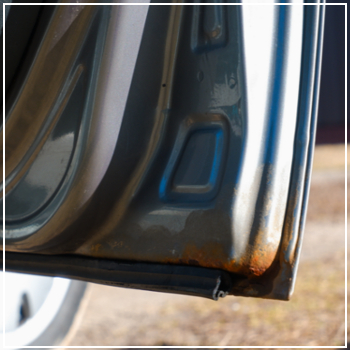Rust typically forms when metal is exposed to moisture, oxygen, and salt. Older vehicles that weren’t built with galvanized steel or aluminum are especially vulnerable. If you live near the coast or in an area where roads are frequently salted in winter, your car is at even higher risk of corrosion. One of the most common places for rust to start is underneath the car, especially after driving on salted roads. However, it can develop anywhere, including on the body, doors, and under the hood. It’s important to regularly inspect your vehicle and take it to a professional if you notice any signs of rust, such as bubbling paint, flaking, or visible patches. The frame rails run along the sides of your vehicle, just below the doors. These areas are often made from thinner steel and are close to the ground, making them more susceptible to rust. If left untreated, rust here can spread quickly and cause costly repairs later on. Wheel wells are constantly exposed to road salt, water, and debris, especially during winter. The thin metal used in these areas makes them particularly prone to corrosion. A visual check is a good start, but don’t forget to feel around inside the wheel wells for hidden damage. The exhaust system is one of the most vulnerable parts of your car. It's constantly exposed to moisture, heat, and road grime. Stainless steel and cold-rolled steel, which are commonly used in exhaust systems, are not immune to rust. Check the tailpipe, muffler, and catalytic converter for signs of damage. A faulty exhaust system can affect emissions and even allow dangerous fumes into the cabin. Rocker panels and the lower part of the quarter panels are close to the ground and often hit by stones, water, and salt. These areas are also more likely to get paint chips, exposing the metal beneath and leading to rust. Be sure to inspect these areas carefully. Many people don’t think about the floor of their car, but it’s a common place for rust to develop. Remove the floor mats and check under the carpeting for any signs of moisture or corrosion. Don’t forget to look in the trunk as well, especially around the spare tire area. Doors are another spot where rust can start, especially if the paint is chipped or if moisture builds up in the drain holes. Inspect both the inside and outside of the doors for any signs of rust and make sure the drain holes are clear to prevent water buildup. While surface rust in the engine bay is common, it usually doesn’t affect performance much. However, older cars with fewer plastic components may have more metal exposed. Check areas like the exhaust manifold, alternator, and strut tower for early signs of corrosion. Newer vehicles often use plastic for inner fenders, which helps prevent rust. But the outer fender, made of sheet metal, can still rust, especially if there are cracks or gaps. This area can also trap moisture and debris, so regular checks are important. The suspension system includes many metal parts that are crucial to your car’s performance. Rust here isn’t just a cosmetic issue—it can become a structural problem if left unchecked. Make sure to check shocks, struts, control arms, and other connected parts for signs of corrosion. If you're worried about rust damaging your car, our team at DaSilva’s Auto Body can help. We offer professional inspections and rustproofing services to protect your vehicle before corrosion takes hold. Contact us today at our Naugatuck location to learn more and keep your car in top condition for years to come. Single French Horn,F Key French Horn,Children French Horn,Single Horn ZhengOu Musical Instruments Co.,LTD , https://www.zomusical.com Unaddressed vehicle rust can lead to serious structural issues, weakening the frame and reducing safety in a collision.
Unaddressed vehicle rust can lead to serious structural issues, weakening the frame and reducing safety in a collision.Where Does Rust Usually Begin?
Frame Rails
Wheel Wells
Exhaust System
Rocker and Quarter Panels
Floors
Doors
The Engine Bay
Fenders
Suspension